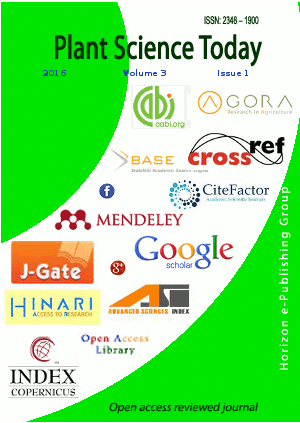Studies on mangrove diversity of India with special reference to Lothian Island Wildlife Sanctuary
DOI:
https://doi.org/10.14719/pst.2016.3.1.186Keywords:
Mangrove, wildlife, sanctuary, succession, zonationAbstract
Mangroves are extremely important bio-resources that are crucial to coastal environment. Indian mangrove vegetation covers about 6,756 sq. km. Along the 7516.6 km long coast line, including island territories. Estimates of the number of species considered, mangroves in the world ranges from 50-90, and in India from 50-60. Mangroves are declining rapidly as they are getting degraded for agriculture, aquaculture, tourism, urban development and over exploitation. India lost 40% of its mangrove area during the last century. The present work is focused on assessing the status of mangrove area in India with special reference to the Lothian Island Wildlife Sanctuary in Sundarbans. Total 30 species were collected during the field visits. Among them 16 species are major mangroves and 14 are mangrove associates. Effective governance structures, better planning for rehabilitation of degraded mangroves, education and awareness building in local communities are needed to conserve, protect and restore the valuable mangrove wetland ecosystems.Downloads
References
Anonymous, 1987. Mangroves in India- Status Report. Government of India, Ministry of Environment and Forests, New Delhi.
Gopal, B. and Krishnamurty, K. 1993. Wetlands of South Asia. In: Whigham, D.F., Dy Kyjova, D. and Hejny, S. (eds.), “Wetlands of the World”: Kluwer Academic Publishers, Netherlands. pp. 345-414. doi:10.1007/978-94-015-8212-4_10
Kathiresan, K. and Qasim, S.Z. 2005. Biodiversity of Mangrove Ecosystems. Hindustan Publishing Corporation (India), New Delhi.
Macintosh, D.J. 1984. Ecology and productivity of Malaysian mangrove crab population. In: Soepadmo, E., Rao, A.N. and Macintosh, D.J. (eds.), Proceeding Asian Symposium on “Mangrove Environment and Research Management” University of Malaya, Kualalampur, Malaysia. Pp. 354-377.
Morgan, J.P. and McIntire, W.G. 1959. Quaternary Geology of the Bengal Basin, East Pakistan and Burma. Bull Geol. Soc. Am. 70: 319-342. doi: 10.1130/0016-7606(1959)70[319:QGOTBB]2.0.CO;2
Naskar, K.R. 2004. Manual of Indian Mangroves. Daya Publishing House, Delhi.
Naskar, K.R. and Mandal, R.N. 1999. Ecology and Biodiversity of Indian Mangroves. 2 vols. Daya Publishing House, Delhi.
Selvam, V. 2003. Environmental classification of mangrove wetlands of India. Curr. Sci. 84 (6): 757-765.
Spalding, M. 1997. The global distribution and status of mangrove ecosystems. International News Letter of Coastal Management- Intercoast Network. Special edition 1: 20-21.
UNESCO, 1984. Handbook of Mangrove Area Management. Edited by Lawrence, S. Hamilton and Snedaker, S.C.
Untawale, A.G. 1986. Hoe to Grow Mangroves? A field guide. Prepared by NIO, Dona Paula, Goa, WWF for Nature, Bombay, India (2nd Edition). pp. 1-9.
Downloads
Published
How to Cite
Issue
Section
License
Copyright and Licence details of published articles
Authors who publish with this journal agree to the following terms:
- Authors retain copyright and grant the journal right of first publication with the work simultaneously licensed under a Creative Commons Attribution License that allows others to share the work with an acknowledgement of the work's authorship and initial publication in this journal.
- Authors are able to enter into separate, additional contractual arrangements for the non-exclusive distribution of the journal's published version of the work (e.g., post it to an institutional repository or publish it in a book), with an acknowledgement of its initial publication in this journal.
Open Access Policy
Plant Science Today is an open access journal. There is no registration required to read any article. All published articles are distributed under the terms of the Creative Commons Attribution License (CC Attribution 4.0), which permits unrestricted use, distribution, and reproduction in any medium, provided the original author and source are credited (https://creativecommons.org/licenses/by/4.0/). Authors are permitted and encouraged to post their work online (e.g., in institutional repositories or on their website) prior to and during the submission process, as it can lead to productive exchanges, as well as earlier and greater citation of published work (See The Effect of Open Access).









